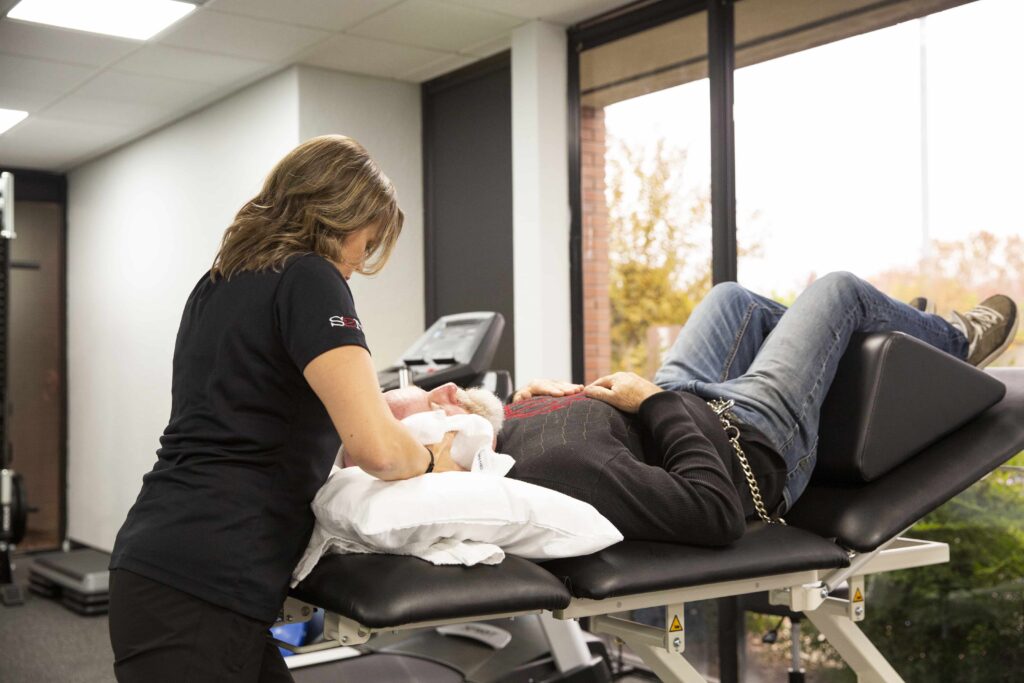Neck injuries are common diagnoses that are generally seen and treated in an outpatient physical therapy clinic. Oftentimes, neck injuries occur after a forceful event, such as an automobile accident. Annually, in the United States, it is estimated that hospitals treat 869,000 cervical spine injuries from traffic accidents. A majority of those injuries resulted in a whiplash (sprain/strain) type of movement.

What Exactly is Whiplash?
Whiplash is a soft tissue injury to the neck resulting from a sudden forceful hyperextension and hyperflexion movement. This debilitating injury can be very painful and can limit a person’s quality of life, so getting treatment is very important. Physical therapy can help these people regain mobility and return to their prior level of functioning.
Whiplash can be broken down into three main elements:
- Whiplash Event
The whiplash event is an involuntary, forceful back-and-forth motion of the neck. This type of injury typically occurs from a rear-end automobile collision, but can also be caused by other traumas, such as rollercoaster rides and contact sports. - Whiplash Injury
The whiplash injury is the problem resulting from the event. These injuries may include a ligament sprain, soft tissue strain, or an injury involving the cervical joints and discs. Whiplash syndrome is a collection of the symptoms from the injury. - Whiplash Syndrome
Symptoms include pain, difficulty moving the neck in all directions, dizziness, headaches, confusion, and sleep disturbances. It is imperative that individuals who suffer from whiplash syndrome seek treatment to prevent their injury from becoming chronic.
How Can Physical Therapy Help?
A person who has suffered a whiplash injury has the option of seeking treatment with a licensed physical therapist. To start, the physical therapist will do a comprehensive examination. This will include taking a full history, completing a physical exam, designing a plan of care, and going over an individualized home exercise program. Even with severe cases of whiplash, individuals benefit from seeking physical therapy to limit long term-impairments and chronic pain.
Beneficial Exercises for Whiplash
1. Cervical Retractions
- In a seated or lying face-up position, gently tuck the chin backward as if making a double chin. Be sure to bring the chin straight back and prevent the head from flexing downward. Do three sets of 10 repetitions, three times a day.
- This exercise is a great starting point if someone has limited, painful motions in all directions. It helps to flex the upper cervical spine and extend the lower cervical spine. The first few repetitions may be difficult and painful, but with gentle movements, the pain should subside and movement should improve. This should not elicit a headache or dizziness. If it does, try a different position (for instance, lying on your back vs. sitting).
2. Scapular Retractions
- In a seated position, relax the shoulders and neck. Slowly squeeze the shoulder blades together, imagining pinching an object between them. Be sure to keep the shoulders and neck relaxed the entire time to prevent shrugging. Do three sets of 10 repetitions, three times a day.
- This exercise is good to start activating the shoulder blades, which can be restricted and painful after a whiplash event. It also helps to strengthen the scapular muscles, which can help to reduce the pressure and strain of the neck. Be sure to keep the neck neutral and not push the head forward.
3. Assisted Towel Rotations
- In a seated position, place a small towel behind the neck. While turning the head towards the right, use the right hand to help guide the towel to assist with rotating the head. Do 10 repetitions for two to three sets and repeat on the other side, three times a day.
- For those who can barely rotate their neck, even for simple tasks like looking over their shoulder while driving or looking at a person next to them, towel rotations can help to gradually improve that motion. It is an active-assisted exercise, meaning that an individual is still using their muscles to do the movements while getting assistance from the towel. If it results in a headache or dizziness, try the exercise in a lying position instead of sitting.

How Can PRO~PT Help?
With over 18 different locations across California’s central valley, PRO~PT has many enthusiastic and empathetic physical therapists and physical therapist assistants to help people get moving and return to their prior level of function. We will tailor a program specifically for you, ensuring that the components are aligned with your specific goals.








